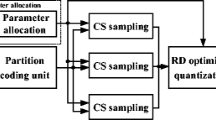Abstract
In this paper, compressive imaging based on spatial correlation (CISC), which uses second-order correlation with the measurement matrix, is introduced to improve the signal-to-noise ratio performance of compressive imaging (CI). Numerical simulations and experiments are performed as well. Referred to the results, it can be seen that CISC performs much better than CI in three common noise environments. This provides the great opportunity to pave the way for real applications.








Similar content being viewed by others
References
Donoho, D.L.: Compressed sensing. Inf. Theory IEEE Trans. 52, 1289–1306 (2006)
Lustig, M., Donoho, D., Pauly, J.M.: Sparse MRI: the application of compressed sensing for rapid MR imaging. Magn. Reson. Med. 58, 1182–1195 (2007)
Eldar, Y.C., Kutyniok, G.: Compressed sensing: theory and applications. Cambridge University Press, New York (2012)
Lustig, M., Donoho, D.L., Santos, J.M., Pauly, J.M.: Compressed sensing MRI. Sig. Process. Mag. IEEE 25, 72–82 (2008)
Shi, G., Liu, D., Gao, D., Liu, Z., Lin, J., Wang, L.: Advances in theory and application of compressed sensing. Acta Electronica Sinica 37, 1070–1081 (2009)
Duarte, M.F., Eldar, Y.C.: Structured compressed sensing: from theory to applications. Signal Process. IEEE Trans. 59, 4053–4085 (2011)
Duarte, M.F., Davenport, M.A., Takhar, D., Laska, J.N., Sun, T., Kelly, K.E., Baraniuk, R.G.: Single-pixel imaging via compressive sampling. IEEE Signal Process. Mag. 25, 83 (2008)
Katz, O., Bromberg, Y., Silberberg, Y.: Compressive ghost imaging. Appl. Phys. Lett. 95, 131110 (2009)
Zhao, C., Gong, W., Chen, M., Li, E., Wang, H., Xu, W., Han, S.: Ghost imaging lidar via sparsity constraints. Appl. Phys. Lett. 101, 141123 (2012)
Gong, W., Bo, Z., Li, E., Han, S.: Experimental investigation of the quality of ghost imaging via sparsity constraints. Appl. Opt. 52, 3510–3515 (2013)
Yu, W., Li, M., Yao, X., Liu, X., Wu, L., Zhai, G.: Adaptive compressive ghost imaging based on wavelet trees and sparse representation. Opt. Express 22, 7133–7144 (2014)
Katkovnik, V., Astola, J.: Compressive sensing computational ghost imaging. JOSA A 29, 1556–1567 (2012)
Willett, R.M., Marcia, R.F., Nichols, J.M.: Compressed sensing for practical optical imaging systems: a tutorial. Opt. Eng. 50, 072601–072601-13 (2011)
Candes, E., Romberg, J.: Sparsity and incoherence in compressive sampling. Inverse Prob. 23, 969 (2007)
Akhlaghi, M.I., Dogariu, A.: Compressive correlation imaging with random illumination[J]. Opt. Lett. 40(19), 4464–4467 (2015)
Gong, W.: High-resolution pseudo-inverse ghost imaging[J]. Photon. Res. 3(5), 234–237 (2015)
Zhang, C., Guo, S., Cao, J., et al.: Object reconstitution using pseudo-inverse for ghost imaging[J]. Opt. Express 22(24), 30063–30073 (2014)
Mandel, L., Wolf, E.: Optical coherence and quantum optics. Cambridge University Press, New York (1995)
Kutyniok, G.: Theory and applications of compressed sensing. arXiv preprint arXiv:1203.3815 (2012)
Figueiredo, M.A., Nowak, R.D., Wright, S.J.: Gradient projection for sparse reconstruction: application to compressed sensing and other inverse problems. Select. Topics Signal Process. IEEE J. 1, 586–597 (2007)
Li, C., Yin, W., Zhang, Y.: User’s guide for TVAL3: TV minimization by augmented lagrangian and alternating direction algorithms. CAAM report (2009)
http://www.caam.rice.edu/~optimization/L1/TVAL3/. Accessed 07 Nov 2013
Dudley, D., Duncan, W.M., Slaughter, J.: Emerging digital micromirror device (DMD) applications. In: Micromachining and Microfabrication, pp. 14–25 (2003)
Acknowledgments
The authors gratefully acknowledge the support from the Seventh Six-talent Peak project of Jiangsu Province (Grant Nos. 2014-DZXX-007), the National Natural Science Foundation of China (Grant Nos. 61271332), the Fundamental Research Funds for the Central Universities (Grant Nos. 30920140112012), the Innovation Fund Project for Key Laboratory of Intelligent Perception and Systems for High-Dimensional Information of Ministry of Education (Grant Nos. JYB201509), and the Fund Project for Low-light-level Night Vision Laboratory (Grant Nos. J20130501).
Author information
Authors and Affiliations
Corresponding author
Appendix 1
Appendix 1
In this second-order correlation function, the product of sensing matrix \(\varPhi\) shown in Eq. (4) and its transpose \(\varPhi^{T}\) is expressed as:
In the design of random patterns, every element in the distribution is generated by a random toolbox, so that the columns of measurement matrix A are independent and satisfy the same distribution. Consequently, we have
where \(t = 1,2, \cdots ,N\),\(\beta\) is a constant and \(r\left( {a\left( t \right),a\left( i \right)} \right)\) is the correlation coefficient between the \(t\)th column and \(i\)th column in the measurement matrix A. Then, the elements in diagonal line of the product \(\varOmega\) are expressed as:
where \(\sigma^{2}\) is the variance of the selected distribution.
Because of the independence of the columns in measurement matrix A, the product of \(r\left( {a\left( t \right),a\left( i \right)} \right)\) and \(r\left( {a\left( {t^{\prime}} \right),a\left( i \right)} \right)\) with \(t \ne t^{\prime}\) satisfies uniform distribution in the open interval \(\left( { - 1, + 1} \right)\), so that we can obtain
Finally, the elements of the sensing matrix \(\varOmega \left( {t,t^{\prime}} \right)\), \(t \ne t^{\prime}\) are equal to zero and we can obtain \(\varOmega \approx \sigma^{4} \beta E\) which proves that the sensing matrix \(\varPhi\) is orthogonal.
Rights and permissions
About this article
Cite this article
Mao, T., Chen, Q., He, W. et al. Improving signal-to-noise ratio performance of compressive imaging based on spatial correlation. Opt Rev 23, 571–578 (2016). https://doi.org/10.1007/s10043-016-0229-3
Received:
Accepted:
Published:
Issue Date:
DOI: https://doi.org/10.1007/s10043-016-0229-3




